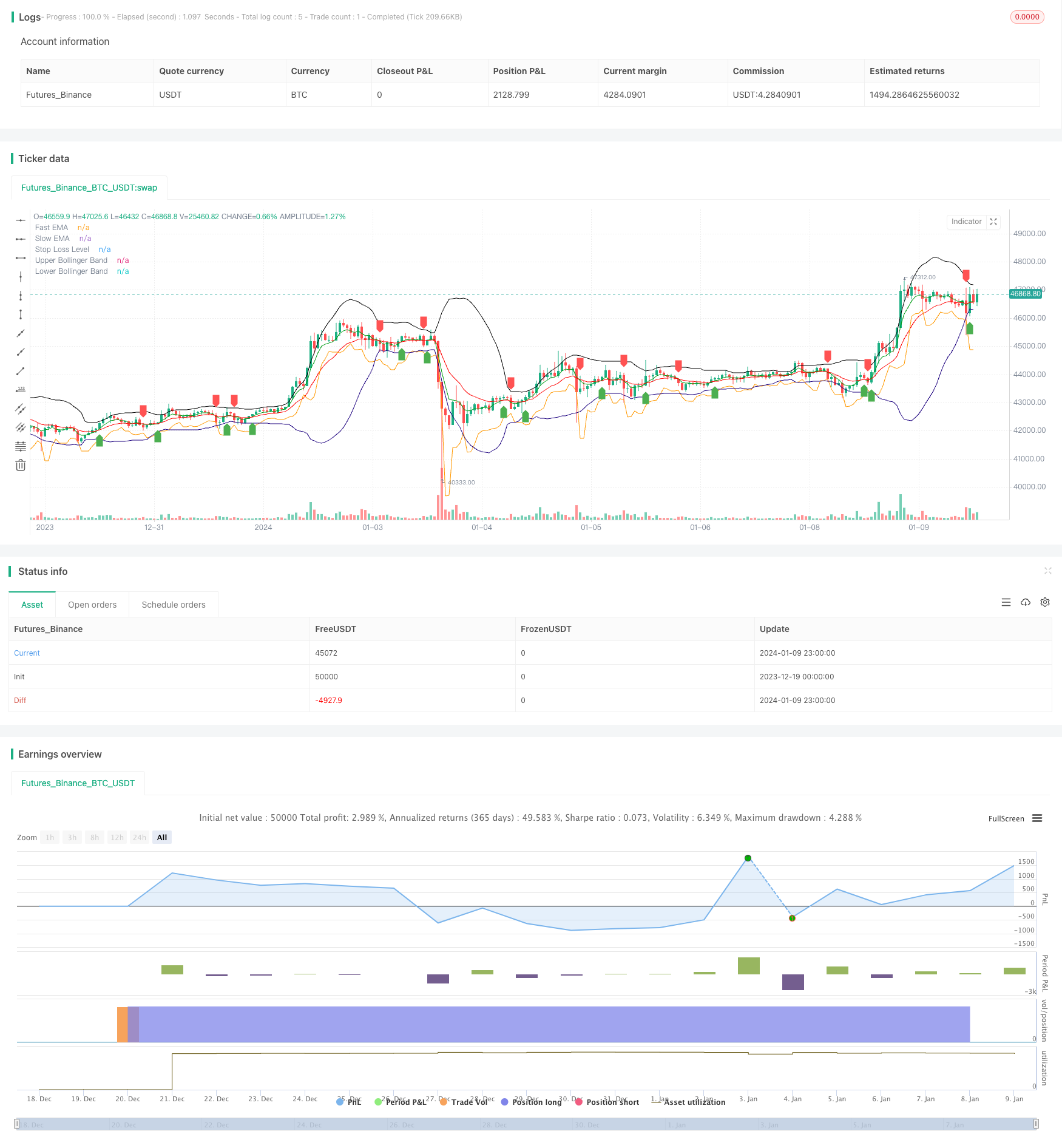
概述
该策略是一种5分钟震荡交易策略,旨在捕捉比特币和黄金市场的短期价格波动,实现盈利。它结合使用EMA均线、布林带指标以及止损方法来实现入场和出场。
策略原理
该策略使用快速EMA指标和慢速EMA指标构建趋势判断系统。当快速EMA上穿慢速EMA时产生买入信号;当快速EMA下穿慢速EMA时产生卖出信号,捕捉短期趋势的转折。
同时,该策略结合布林带指标判断价格波动区间。只有当价格接近布林带上轨或中轨时,才产生交易信号。这能过滤掉大部分假信号。
入场后,该策略使用ATR指标计算止损位。并且设定止损为入场蜡烛的低点再减去n倍ATR,用于控制每个交易的风险。
优势分析
该策略最大的优势在于 capturing short-term swings and price volatility, taking small but consistent profits 每次只追求小利润,但持续盈利。通过快速EMA和慢速EMA的配合,能快速判断短期趋势;布林带和ATR止损能有效控制风险,是一种相对稳定的震荡策略。
另外, 5分钟周期操作使得该策略交易频率较高,这也增大了其盈利空间。同时也方便进行人工监控或优化。
风险分析
该策略主要风险在于 whipsaws leading to multiple small losses 抄底反转造成的小额连续亏损。当价格在一个范围内震荡时,EMA交叉信号可能频繁出现,造成不必要的交易和连续小额亏损。
此外,作为一个短期震荡策略,它也面临着高交易频率带来的交易成本风险。如果交易成本过高,可能会侵蚀利润空间。
优化方向
该策略可以通过以下方式进行优化:
增加其他oscillators作为辅助判断指标,如RSI, Stochastics等,避免在震荡市场中被套。
增加machine learning模型判断趋势方向,提高入场的准确性。
利用遗传算法、随机森林等方法自动优化参数,使之更符合当下市场情况。
结合深度学习判断关键支持位和关键压力位,设定更优的止损位置。
测试不同交易品种如股指、外汇、加密货币等,选择交易效果最好的品种作为主要交易标的。
总结
总的来说,该策略作为一个短期频繁交易策略,能够有效捕捉价格短期震荡和趋势反转,通过快速EMA判断,布林带过滤和ATR止损来控制风险,可以获得稳定收益。如果进一步优化和改进,在降低交易频率的同时保持盈利能力,将是一个非常具有潜力的量化策略。
/*backtest
start: 2023-12-19 00:00:00
end: 2024-01-10 00:00:00
period: 1h
basePeriod: 15m
exchanges: [{"eid":"Futures_Binance","currency":"BTC_USDT"}]
*/
// This source code is subject to the terms of the Mozilla Public License 2.0 at https://mozilla.org/MPL/2.0/
// © singhak8757
//@version=5
strategy("Bitcoin and Gold 5min Scalping Strategy2.0", overlay=true)
// Input parameters
fastLength = input(5, title="Fast EMA Length")
slowLength = input(13, title="Slow EMA Length")
bollingerLength = input(20, title="Bollinger Band Length")
bollingerMultiplier = input(2, title="Bollinger Band Multiplier")
stopLossMultiplier = input(1, title="Stop Loss Multiplier")
// Calculate EMAs
fastEMA = ta.ema(close, fastLength)
slowEMA = ta.ema(close, slowLength)
// Calculate Bollinger Bands
basis = ta.sma(close, bollingerLength)
upperBand = basis + bollingerMultiplier * ta.stdev(close, bollingerLength)
lowerBand = basis - bollingerMultiplier * ta.stdev(close, bollingerLength)
// Buy condition
buyCondition = ta.crossover(fastEMA, slowEMA) and (close <= upperBand or close <= basis)
// Sell condition
sellCondition = ta.crossunder(fastEMA, slowEMA) and (close >= lowerBand or close >= basis)
// Calculate stop loss level
stopLossLevel = ta.lowest(low, 2)[1] - stopLossMultiplier * ta.atr(14)
// Plot EMAs
plot(fastEMA, color=color.rgb(0, 156, 21), title="Fast EMA")
plot(slowEMA, color=color.rgb(255, 0, 0), title="Slow EMA")
// Plot Bollinger Bands
plot(upperBand, color=color.new(#000000, 0), title="Upper Bollinger Band")
plot(lowerBand, color=color.new(#1b007e, 0), title="Lower Bollinger Band")
// Plot Buy and Sell signals
plotshape(series=buyCondition, title="Buy Signal", color=color.green, style=shape.labelup, location=location.belowbar)
plotshape(series=sellCondition, title="Sell Signal", color=color.red, style=shape.labeldown, location=location.abovebar)
// Plot Stop Loss level
plot(stopLossLevel, color=color.orange, title="Stop Loss Level")
// Strategy logic
strategy.entry("Buy", strategy.long, when = buyCondition)
strategy.exit("Stop Loss/Close", from_entry="Buy", loss=stopLossLevel)
strategy.close("Sell", when = sellCondition)